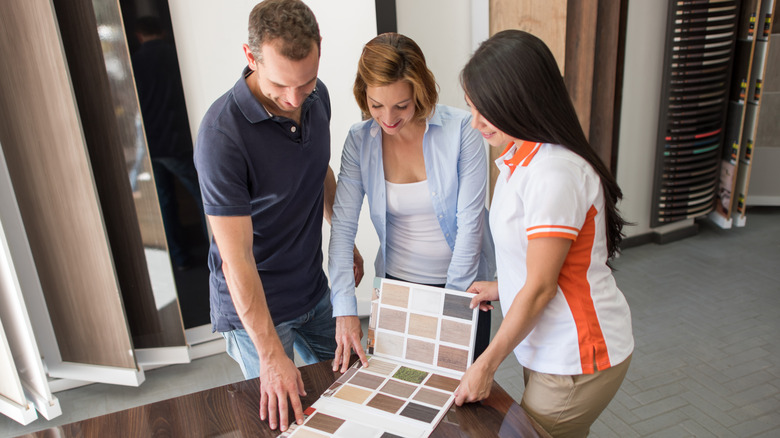The Eclectic Flooring Trend You Should Expect To See In 2025
The new year is kicking off with some exciting strides in home design, with daring floor trends that are pushing minimalism to the sidelines. While millennial gray was once a popular choice, it's now the floor color that will make your home look dated in 2025 — urging homeowners to ditch similar bland flooring for something more eclectic. You may be skeptical about just how bold new flooring trends can get, especially given the well-known array of materials already available. But the latest trend does more than reintroduce familiar floor styles — it's all about mixing different materials in your flooring.
Mixed material flooring creates a stylish contrast that feels both fresh and unique, but it also requires some careful consideration to execute properly. There's a fine line between mixed material floors that offer a chic depth and those that just look uncoordinated and busy. You'll need to figure out which materials will work best to complement each other, and how you can integrate them into your design. While the process may be more complex most singular flooring options — the impressive results can make it all worthwhile.
Choosing compatible materials for mixed flooring
Two of the flooring trends that'll be taking over 2025 are natural textures and bold patterns, and the mixed material trend is a great way to embrace both. That said, maintaining a sense of cohesion is crucial. When picking the materials you want to combine, consider your color palette — whether you're aiming for a subtle or striking contrast, the tones should complement each other. Look at the undertones and color intensities of your choices to make sure they will blend well in your final design. For instance, if you're mixing hardwood with various ceramic tile colors, the wood's colors should have a similar palette to the ceramic tones.
Aside from color, the texture of your materials will also have a big impact on your final design, and your choices should mix well to create visual interest. For example, combining sleek marble and textured wood can offer a beautiful sense of depth and contrast. However, you should keep in mind that when mixing flooring materials, you'll need to balance color and textural contrast to avoid overwhelming the space. Creating too much variation within both color and texture may end up looking overly chaotic. Prioritize balance when mixing your materials, and go for choices that complement rather than compete with each other, so you can achieve a harmonious design.
Designing mixed materials for stylish impact
If the mixed material trend interests you, it's helpful to consider some tips on how to seamlessly use mismatched flooring in your house for a successful execution. One approach is create stylish transitions between materials, rather than abrupt deviations — transitioning materials between rooms or certain zones in open-concept spaces can help you achieve this look. For instance, if your goal is create a focal point in a specific zone, incorporate your contrasting flooring over the area you want to highlight.
To emphasize certain zones and add depth to your design, consider using borders. A simple border framing a more complex pattern and material can help define the space without disrupting the overall flow of your design. If you want a more widespread integration, cohesive patterns can help blend different materials throughout your flooring. For instance, using a herringbone pattern with a combination of wood and ceramic tiles can give you a strong visual contrast while still maintaining a complementary structure. There are many different ways you can get creative with different combinations and designs of mixed flooring materials — but being mindful in your approach will make all the difference.
